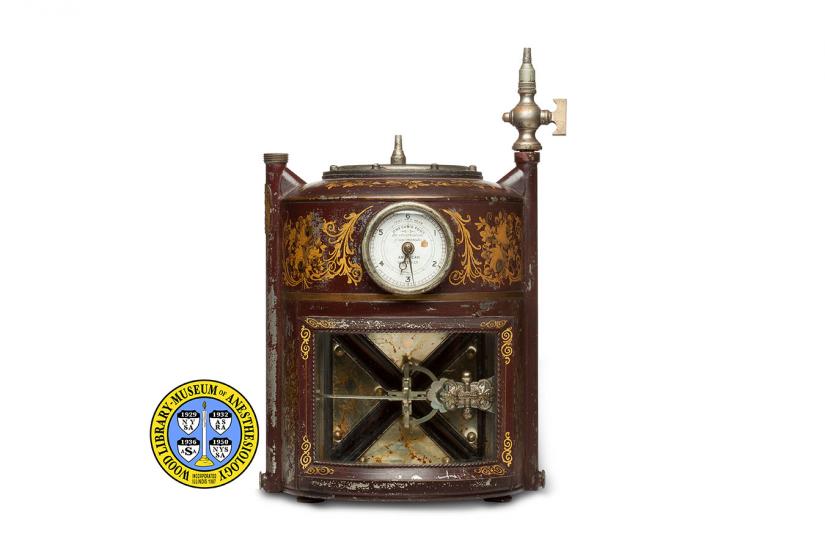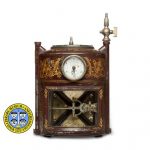American Meter
"Gasometers" were machines built to store and deliver a single gas, either nitrous oxide for anesthesia, or oxygen for respiratory therapy. Nitrous oxide gasometers were primarily used in dentists' offices, and were common from the 1860s through the 1910s. Most gasometers had a reservoir that held several gallons of the gas; some held as much as 150 gallons. The small apparatus shown here was built by the American Meter Company of New York, which manufactured meters to supply and measure natural gas for household lighting. Similar gas meters were used by Dr. Carl Connell as the basis for his delicately calibrated Anaesthetometer.
Catalog Record: American Meter
Access Key: aknl
Accession No.: 1990-12-09-1
Title: [Gas meter] / American Meter Co.
Corporate Author: American Meter Company.
Title variation: Alt Title
Title: American meter apparatus.
Title variation: Alt Title
Title: Ornamental gas meter.
Title variation: Alt Title
Title: Decorative gas meter.
Title variation: Alt Title
Title: Parlor gas meter.
Title variation: Alt Title
Title: Ornamented gasmeter.
Publisher: [Location of manufacture not indicated] : American Meter Company, [1860-1915].
Physical Descript: 1 gas meter : metals, glass, leather, paint ; 136.5 x 23.5 x 22 cm.
Subject: Anesthesia, Inhalation – instrumentation.
Subject: Flowmeters – history.
Subject: Nitrous Oxide.
Subject: Anesthesia, Dental – history.
Note Type: General
Notes: The early date (1860) in the date range for the possible year of manufacture
is based on the earliest reference that was found for a close match to this
style of decorative gas meter (Online Equipment Museum of Gas Analytical
Services). The later year is an estimate based on advertisements, American
Meter Co. product catalogs, and the year that Dr. Karl Connell introduced
his Anesthetometer (about 1914).
Note Type: Citation
Notes: The American Meter Co. [advertisement]. Am Gas Light J. March 21,
1892;56(12):415.
Note Type: Citation
Notes: American Meter Co. [advertisement]. Am Gas Light J. July 3, 1893;59(1):775.
Note Type: Citation
Notes: Commercial department: gas meters, American Meter Company, N. Y. Gas Age.
February 1, 1913;31(3):162.
Note Type: Citation
Notes: Illustrated Catalogue of Gas Apparatus and Appliances. New York, NY: The
American Meter Company; 1914.
Note Type: Citation
Notes: Equipment museum. Gas Analytical Services website. https://gasana.com/museum.
php. Accessed November 1, 2013.
Note Type: Citation
Notes: Gas Meters and Other Apparatus Pertaining to the Correct Measurement and
Testing of Gas. New York: American Meter Company, Inc.:1919. books.google.
com/books?id=kikxAQAAMAAJ. Accessed November 6, 2013.
Note Type: Citation
Notes: Myers DP. Gaslighting in America: A Guide for Historic Preservation.
Washington : U.S. Dept. of the Interior, Heritage Conservation and Recreation
Service, Office of Archeology and Historic Preservation, Technical
Preservation Services Division; 1978:Plate 112. https://www.nps.
gov/history/history/online_books/hcrs/myers/plate12.htm. Accessed November 6,
2013.
Note Type: Citation
Notes: Mooney W. The American Gas Engineer and Superintendents Hand Book, Consisting
of Rules, Reference Tables and Original Matter Pertaining to the Manufacture,
Manipulation and Distribution of Illuminating Gas. New York: Published by the
author; 1888;pages 11-12 of advertisements at end of monograph.
Note Type: Citation
Notes: Smithsonian Institution. Parlor gas meter. History Wired website.
https://historywired.si.edu/object.cfm?ID=508. Accessed November 13, 2013.
Note Type: Physical Description
Notes: One cylindrical gas meter with a clear glass view into the functional
internal parts on the top and lower front; The exterior is painted red and
decorated with painted flowers and vines and stencilled in gilt; A single
circular index is located in the upper front of the meter; It is graduated in
multiple circular scales and numbered; Text printed in the index includes,
“FEET PER HOUR[new line] ONE CUBIC FOOT [new line] By observation of one
minute [new line] AMERICAN METER COMPANY”; There is a significant amount of
rust and flaking of paint on the exterior of the meter.
Note Type: Reproduction
Notes: Photographed by Mr. Steve Donisch, June 10, 2013.
Note Type: Historical
Notes: Decorative gas meters, such as the one described here from the second half of
the 19th century, were manufactured to measure the amount of natural gas used
in a home for lighting and cooking. However, there was no reason to limit
their use to the measurement of natural gas. Oral histories of dentists and
anesthesiologists tell us that dry gas meters had also been used to measure
and regulate the flow of medical gases, such as nitrous oxide and oxygen. In
essence they were used much like a modern flowmeter is used, and differ from
gasometers in that they did not hold liquid nitrous oxide or act as a
reservoir for large quantities of the gas.
The decorative gas meter described here came from the personal collection of
Canadian anesthesiologist Dr. Eric Webb. Dr. Webb was one of the first
‘ambulatory’ (out-patient) anesthesiologists in North America and he kept
this meter because it had once been used as a flow meter to administer
nitrous oxide in Victoria, British Columbia.
Most gas meters were not decorative, but were plain and placed in areas such
as the basement. However, some homeowners took great pride in having gas
fixtures and appliances and chose a gas meter that could decorate the parlor
and ‘announce’ the presence of gas in the home.
Interestingly, this gas meter was made by The American Meter Company. Dr.
Karl Connell used meters from this manufacturer when developing his early
anesthesia machine called the Anaesthetometer.
Note Type: Publication
Notes: Norman OE. The Romance of the Gas Industry. Chicago: A.C. McClurg & Company;
1922. https://archive.org/details/romanceofgasindu00norm. Accessed November 6
2013.
Note Type: Exhibition
Notes: Selected for the WLM website (noted November 8, 2013).


